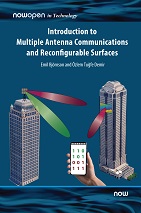Introduction to Multiple Antenna Communications and Reconfigurable Surfaces

By Emil Björnson, KTH Royal Institute of Technology, Sweden, emilbjo@kth.se | Özlem Tuğfe Demir, KTH Royal Institute of Technology, Sweden
Publication Date: 17 Jan 2024
Suggested Citation: Emil Björnson, Özlem Tuğfe Demir (2024), "Introduction to Multiple Antenna Communications and Reconfigurable Surfaces", Boston-Delft: now publishers, http://dx.doi.org/10.1561/9781638283157
Downloaded: 272421 times
Description
Wireless communication is the backbone of the digitized society, where everything is connected and intelligent. Access points and devices are nowadays equipped with multiple antennas to achieve higher data rates, better reliability, and support more users than in the past. This book gives a gentle introduction to multiple antenna communications with a focus on system modeling, channel capacity theory, algorithms, and practical implications. The basics of wireless localization, radar sensing, and controllable reflection through reconfigurable surfaces are also covered. The goal is to provide the reader with a solid understanding of this transformative technology that changes how wireless networks are designed and operated, today and in the future.
The first three chapters cover the fundamentals of wireless channels, and the main benefits of using multiple antennas are identified: beamforming, diversity, and spatial multiplexing. The theory and signal processing algorithms for multiple-input multiple-output (MIMO) communications with antenna arrays at the transmitter and receiver are progressively developed. The next two chapters utilize these results to study point-to-point MIMO channels under line-of-sight (LOS) and non-LOS conditions, covering the shape of signal beams, impact of array geometry, polarization, and ways to achieve reliable communication over fading channels. The book then shifts focus to multi-user MIMO channels, where interference between devices is managed by spatial processing. The next chapter extends the theory to multicarrier channels and explains practical digital, analog, and hybrid hardware implementations. The last two chapters cover the role of multiple antennas in localization and sensing, and how reconfigurable surfaces can improve both communication and sensing systems.
The text was developed as the textbook for a university course and builds on the reader's previous knowledge of signals and systems, linear algebra, probability theory, and digital communications. Each chapter contains numerous examples, exercises, and simulation results that can be reproduced using accompanying code.
-
ISBN: 978-1-63828-315-7
688 pp. Open Access (.pdf) This is published under the terms of CC BY-NC
